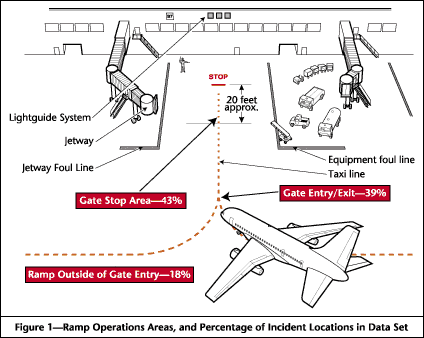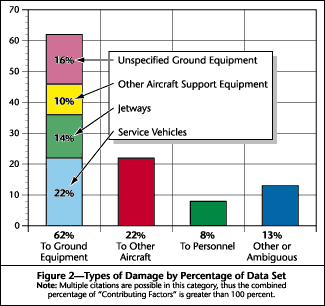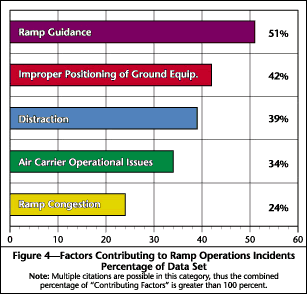![]()
Issue Number 8 : June 1996
|
|
Issue Number 8 : June 1996 |

by Roy Chamberlin, Charles Drew, Marcia Patten, and Robert Matchette
"As I was approaching Gate XX, I shut down the #2 engine (per our Ops Manual). I was momentarily distracted inside the cockpit...When I looked back outside, I saw about four ramp personnel around one of our gates, so I turned into that gate. One of the ramp personnel jumped up and crossed his arms, so I stopped the airplane. It was Gate XY, not XX. There was enough room to make a turn to the left to taxi over to Gate XX. I added power on the #1 engine. I did not notice the power setting, as I was clearing outside to my left.
During the left turn, the jet blast from the #1 engine blew a mechanic off a maintenance stand. It also blew part of an engine cowling off the stand.
Perhaps if I had not been so focused outside, I would have been more aware of my power application. In future situations, I will...shut down and use a tug to reposition if there is any doubt about jet blast." (#260480)
Airport Ramp Safety has been given much attention recently in reports and papers by a number of safety organizations. In spite of their efforts, and those of air carrier safety departments, damage to aircraft and ground equipment and injury to personnel continue to occur during ramp operations. A safety specialist from the United Kingdom Flight Safety Committee stated the loss in terms almost everyone can understand: worldwide, the dollar equivalent of fifteen Boeing 747-400s is lost each year to equipment damage during ramp operations. [ Endnote 1.]
Since 1986, the Aviation Safety Reporting System (ASRS) has received more than 370 incident reports describing equipment damage and personnel injury during ramp operations.
A detailed study of 182 relevant reports was undertaken to further identify the major areas of risk in ramp operations, and the flight crew and ground crew performance factors that contributed to these events. To be included in the set of relevant reports, an incident had to meet each of the following criteria: 1) involve a ramp operation of an FAR Part 121 or Part 135 aircraft, or a two-crew corporate aircraft; 2) mention damage to aircraft or ground equipment, or injury to flight or ground personnel or passengers; and 3) directly involve the flight crew (that is, the flight crew occupied the cockpit at the time of the incident, and their actions or inactions may have contributed to the incident).
As expected relative to the selection criteria, 80% of the reports were from Part 121 primary air carriers, and 87% of the incidents occurred during passenger-carrying operations. Nearly all the reporters were flight crew; only one report from a ground crew member was in the study set. Specific environmental factors were studied to determine to what extent they influenced the occurrence of ramp incidents. The time of day, month of the year, location (city and state), and weather conditions referenced in the study set generally mirrored the distribution of those factors in the nearly 60,000 full-form records in the ASRS database. Overall, environmental factors do not appear to be directly relevant to the reported ramp incidents.
At first glance, one might expect an even distribution of ramp incidents during arrivals and departures. However, in the study set, the aircraft was making its arrival at the time of the incident in 58% of the reports and its departure in 35% of the reports (another 7% encompass miscellaneous events, such as gate changes, power-outs, etc.). Different procedures--or lack of procedures--during arrival and departure may account for this disparity.
On arrival, the ramp procedures may be loosely defined. The flight crew is often no longer in contact with ATC, or even with company ramp control, once the aircraft transitions to the company gate area. Further, the flight crew communications with ground crew are likely to be primarily visual (hand signals or guide light systems).
In contrast, departure operations tend to be controlled by procedures and checklists. The flight crew is usually in radio contact with ATC or company ramp control before any aircraft movement begins from the gate. In addition, there is more likely to be verbal communication with the ground crew during the early segments of a departure procedure. In spite of increased levels of communication, a misunderstanding placed the next crew's 747 in the path of another 747, causing damage to both aircraft:
As shown in Figure 1 (below), the Ramp Entry or Exit Area--the area adjacent to a taxiway and leading to or from a company ramp--was the site of the incident in 18% of the study set. Aircraft operating in this area are usually in communication with, and under the control of, ATC. Another 39% of the incidents occurred at the Gate Entry or Exit Area, where taxi lines converge leading into or out of the gate area. In this area, an aircraft is less likely to be in communication with some controlling agency, and may now be relying on a company ramp control procedure or ground crew input for guidance. The largest percentage of the incidents, 43%, occurred within the Gate Stop Area, that is, within 20 feet of the nosewheel parking line. At this point, the flight crew is usually relying entirely on ground crew guidance for clearance from obstacles and for final taxi instructions. This guidance is often hand signals from ground crew personnel in the form of an all-clear salute, or signals from parking or guidance light systems mounted on the terminal building.

It is interesting to note that there were more incidents in the gate stop area during arrival (48%) than during departure (31%). A possible explanation is that there are more obstacles to encounter when entering the more congested area next to gates and terminal buildings. It was also noted that there were fewer incidents on the ramp fringe areas during arrival (13%) than during departure (30%). This may be related to the large number of pushback, power-out, and power-turn procedures occurring during departure operations.
Ground equipment, and by association, ground personnel, appear to be most vulnerable to damage or injury in ramp operation incidents. Ground equipment in general was the clear "loser" in the reported incidents, as depicted in Figure 2. Ground equipment damage occurred most often in the gate stop area, less so in the gate entry/exit areas, and rarely on the ramp fringe areas.

In contrast, aircraft-to-aircraft damage usually occurred in the ramp and gate entry/exit areas, where the taxiing aircraft were sharing the common maneuvering area and were likely to be in radio contact with a controlling agency. Damage to aircraft at the gate stop area was less common in Part 121 operations than Part 135.
There were 15 reports of injury to personnel, and two-thirds of those injured were ground crew members. Although this number does not seem substantial, it obviously represents a substantial impact in the lives of the persons who were injured. It also represents a potentially large financial loss to the company in flight delays, employee lost-time, insurance, medical, and other costs.
Reporters stated that they were provided with ground personnel for ramp guidance in 64% of the incidents. The marshaler is the "PIC" of the ground crew, and has primary responsibility for correct signals being passed to the flight crew. The marshaler is often a relatively senior member of the ground crew, and usually has received specific training for this position. Other ground crew members may have varying degrees of training and experience in their positions. These positions include:
Marshalers were reported as present in 56% of the incidents, and one or more wingwalkers were present in 17% of the incidents. According to reporters, marshalers were not present, but should have been, in 12% of the incidents. Based on this recommendation from flight crews, it appears that the presence of a marshaler might have had a positive effect in the 13% of incidents in which no ground crew member was present (see Figure 3). Reporters also concluded that wingwalkers should have been present in 26% of the incidents. In 20/20 hindsight, many reporters, like this Captain, clearly recognized the value of wingwalkers:
Is More Better? Figure 3 (below) shows the number of ground crew personnel present at the time of the reported incident. These numbers may suggest that "more is better," but this is not an infallible conclusion. A small four- or six-passenger Part 135 aircraft on a spacious ramp may have little need for a large ground crew. On the other hand, a Boeing 747 making its way into a crowded gate may require three, four, or more ground personnel to navigate safely. In practice, many companies assign only one or two ground crew members to an aircraft. The numbers and functions of ground personnel assigned to an aircraft may be gate-specific, depending on gate location or the presence of certain aircraft parked at an adjacent gate. However, the fact remains that the study set contained few reports that cited three or more ground crew members as being present.

Reporters attributed error to ground crew performance in over half the reports, but also blamed themselves almost as frequently. The flight crews defined their own errors in two ways: first, specific tasks or actions that they performed incorrectly (usually a failure to follow procedures); and second, incorrect or inappropriate responses to ground crew actions or instructions (usually faulty decision-making about the hazards involved in following those instructions).
Figure 4 (below) summarizes reporters' views of the primary factors that contributed to the reported incidents.

Ramp guidance issues included incorrect or inappropriate gate assignments; inadequate ground crew staffing during aircraft movement, especially during night and bad weather operations; and improper taxi or parking instructions from ATC, company ramp control, or ground personnel. Non-human guidance systems were not spared reporters' criticisms: marginally visible taxi lines, and poorly-placed lead-in lights and building-mounted light systems were also cited as contributing factors to incidents. Some reporters specifically recommended making the wingwalker position mandatory for all ramp operations, to supplement the mechanical systems.
Communication is an integral part of ramp guidance. Reporters were communicating--verbally, visually, or both--with the ramp guidance personnel in 79% of the incidents. Unfortunately, however, 52% of the reporters stated that the communication with the guidance personnel was poor. One particular communication technique--the nearly universal "all-clear" salute--was notably absent in many of the reported incidents. Ineffective communication was at the heart of this towing incident that resulted in aircraft damage:
It is interesting to note that in 85% of the reports, the reporter's aircraft was moving at the time of the incident, and that 80% of these movements were considered "normal." In almost half of these incidents, the flight crew reported that a ground crew member was still signaling "come ahead," even after the aircraft had come into contact with an item of ground equipment. This type of miscommunication is illustrated in a report excerpt from a Part 135 Captain:
Related to ramp guidance is the issue of ramp congestion. Increasing numbers of flights, stringent aircraft scheduling requirements, and efforts to squeeze large jets into gates originally designed for much smaller aircraft, contribute to traffic jams and tight quarters on the ramp. The combination of ramp congestion and lack of staffing were the precursors to this Captain's tale of hitting a cargo loader:
Improper or premature positioning of ground equipment was another major factor contributing to incidents. Reporters cited that ground equipment was sometimes parked outside the marked areas, thus encroaching on aircraft movement areas. Some reporters pointed out that the flight crew is usually unable to determine whether ground equipment is parked outside the aircraft movement area, and so must rely on vehicle drivers and jetway operators to keep their equipment within the equipment foul lines.
Other reporters noted that some aircraft support vehicles and jetways had been moved toward the aircraft before it had stopped at the designated stop point, and before the crew had given an "all-clear" signal (usually by turning off the aircraft's rotating beacon). Such was the case in the following report:
Reporters often mentioned distraction due to cockpit duties, ATC or company communication, checklists, and fatigue. Some reporters continued with an operation even when something didn't look right, or was blatantly wrong. Flight crews also admitted to failing to request a tug to get into, or out of, a tight parking place. The latter two problems may have been responses to schedule pressure or to demand for on-time performance, also mentioned by many flight crew members as an underlying cause of incidents.
These and other sources of distraction also caused a marked reduction of cockpit coordination and CRM skills. A plane's rear airstairs received damage when the crew became distracted by multiple demands, and failed to act as a team:
Reporters identified two types of air carrier operations management issues: some cited instances of a crew's failure to follow an established policy or procedure; others referred to a lack of established procedure. In the following report, the crew followed one company procedure--requesting a tow-in on an icy ramp; however, misunderstandings about a new towing procedure paved the way for a ramp incident:
Reporters offered suggestions for alleviating some of these procedural errors--for example, that simulator training in ramp operations and pushback procedures be instituted for pilots, and that both flight crews and ground crews receive parallel training (that is, each group receive the same information and training that is provided the other). Parallel training would promote a clearer understanding of flight/ground crew responsibilities and expectations during ramp and gate operations.
There are a number of actions that air carrier managers can take to reduce ramp incidents. The following recommendations are based on the findings presented above and on suggestions from a panel of highly-experienced ASRS analysts.
Ultimately, however, the responsibility for safe operation of the aircraft rests with the flight crew. Therefore, regardless of any actual or assumed inadequacy on the part of management or the ground crew, it is up to the flight crew to take action to prevent incidents. The discussion presented above suggests the following preventive actions for flight crews:
| Reproduction and redistribution of ASRS Directline articles is not only permitted--it is encouraged. We ask that you give attibution to ASRS Directline, to the Aviation Safety Reporting System (ASRS), and of course, to the authors of each article. |